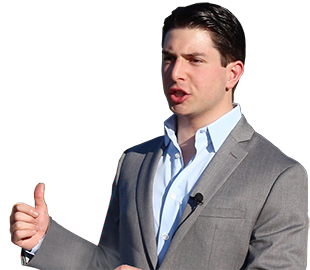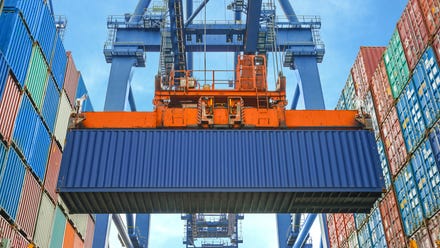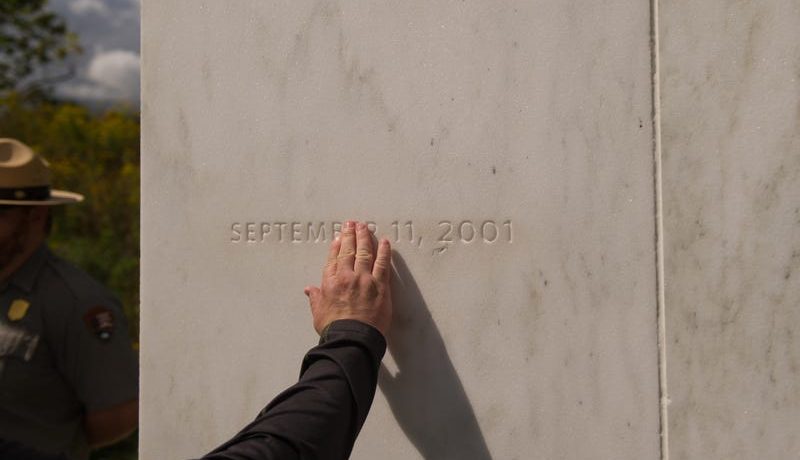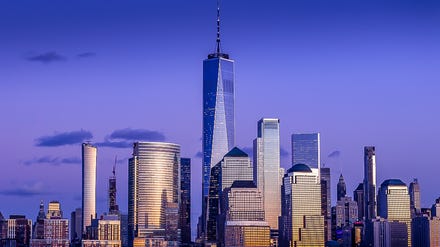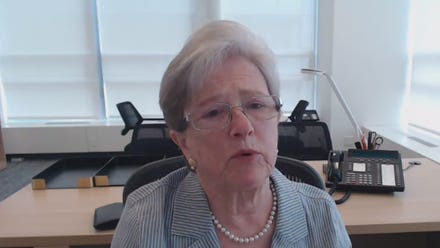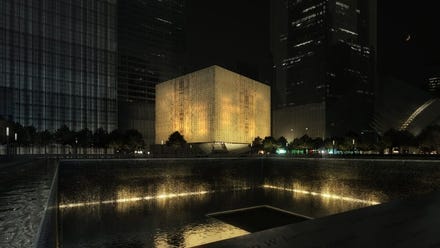
-
Long Island Retail Supplier Faces Supply Chain Hurdles Ahead of Holiday Rush
Post Views: 605By Joe Connolly and Neil A. Carousso
NEW YORK (WCBS 880) — Small businesses are struggling to handle new financial pressures as the COVID-19 pandemic extends into its 18th month.
Hicksville-based Econoco Corporation, which supplies store fixtures and displays to retailers, is now facing a myriad of supply chain issues because of pandemic-related manufacturing holdups overseas and surging demand for consumer products.
“Things will get worse before it gets better,” said Econoco CEO Barry Rosenberg on the WCBS Small Business Spotlight, sponsored by Dime Community Bank.
He said delays are amplified ahead of the holidays.
“(Independent retailers are) not willing to wait 3-4 months for a custom made product,” Rosenberg explained. “We’re struggling to get containers on board ocean freight lines that can ship here to New York. This is the biggest problem we’re facing.”
He told Joe Connolly and Neil A. Carousso that he is now competing with and bidding against big-box stores like Costco for space on ships. All of these factors are driving up prices and being passed onto his customers. Last October, Rosenberg said, it cost them $3,000 for a 40-foot container aboard those ships. But, 11 months later, it costs $23,000 to ship his products from China to the U.S.
“We’ve implemented three price increases to the tune of almost 50 percent,” said Rosenberg. “It’s really a shame, but this is the direction we’re headed and we’re in an inflationary time.”
He lamented that it is disproportionately affecting small and mid-size businesses.
He told WCBS 880 large retailers like Amazon and Grainger, which Econoco supplies racks, mannequins, hangers and other store fixtures to, have demanded that they absorb the increased costs. Rosenberg pulled all inventory from their platforms because it wouldn’t make the company profitable.
“They’re squeezing the little guy,” said Rosenberg.
But, the most successful businesses are constantly making adjustments. Exploring new markets like cannabis is one reason why Econoco has stayed in business on Long Island for 96 years.
Recognizing that retail footprints are shrinking along with demand for his store displays, Rosenberg sought out areas in retail that are not suffering. He found a growing niche in legal cannabis and launched DisplayDispensary.com where he supplies cannabis displays, cash wraps and acrylic retail display showcases to licensed vendors.
“Now, you’ve got 13 states that have recreational cannabis legal, starting out on the West Coast, and I think we were late to the dance, but we are hoping to build our brand,” he said.
New York, New Jersey and Connecticut are in the process of setting up state licensed marketplaces.
“If it’s anything like Colorado or Washington state, you’re going to have two or three cannabis stores on every block,” said Rosenberg.
Recreational use of cannabis has been legalized in 18 states.
The Hicksville-based retail supplier is also changing how they sell. Rosenberg has traditionally hired a robust outside sales team to engage with big buyers, but he is now seeing smaller and leaner competitors signing major retailers such as Banana Republic – a clothing giant an Econoco sales representative had been trying to hook for years.
“What’s happening is, the buyers are getting younger and they are using the Internet for basic purposes,” said Rosenberg, continuing, “There’s a lot less sales people that are meeting at offices, particularly during the pandemic.
Obviously, offices are closed, so you can’t go there. Nobody’s taking anyone to lunch or to dinner or to ballgames.”The pandemic disruption is opening the door to new opportunities for smaller businesses looking to get big clients.
In pivoting, Rosenberg has upgraded four websites in the last year and a half and is doing more digital advertising to reach those buyers.
See more on the current business challenges and creative solutions on the WCBS Small Business Spotlight video above.
-
Commemorating 9/11: Never Forgotten 20 Years Later
Post Views: 678Produced by Neil A. Carousso
NEW YORK (WCBS 880) — At some point, everyone has seen or heard the heartbreaking news coverage of 9/11. Because all the reporters were so busy describing what they saw, it’s not often that they get to share what their personal experiences of the event were — until now.
This week, WCBS 880 has assembled four veteran journalists who worked and witnessed the attacks on the World Trade Center from varying angles that day.
Speaking with WCBS 880’s Wayne Cabot, former anchors Pat Carroll and Jeff Kaplan join reporters Sean Adams and Tom Kaminski to share each of their own real-time experiences, as well as their reflections since.
Despite seeing and processing everything differently, nothing was more important than the facts that day.
“All of your broadcast training, every breaking news story you ever covered in your whole life – suddenly you [realized] that it was preparing you for this moment,” Carroll says.
While nothing could ever prepare them for a tragedy of that caliber, Carroll adds, “We just went with it as though we had been preparing for this throughout our careers…[we knew] we were important. We were necessary.”
“It was absolutely impossible to comprehend the enormity of the situation,” Adams added. He was one of the street reporters closest to the towers that day, and witnessed the first building collapse.
He says he couldn’t believe what was happening, “because [it was] so much larger than anything [he’d] ever experienced before.”
https://omny.fm/shows/880-weekly-rewind/9-11-special-never-forgotten-20-years-laterHe also recalled telling himself, “Do not get killed,” that day because he couldn’t be of any use dead. With so much mayhem at the scene, it wasn’t until the South Tower collapsed that he was able to deliver his first live report.
As crucial as that report was to the people of New York, Adams revealed that the report meant something more to his family because it confirmed to them that he was still alive.
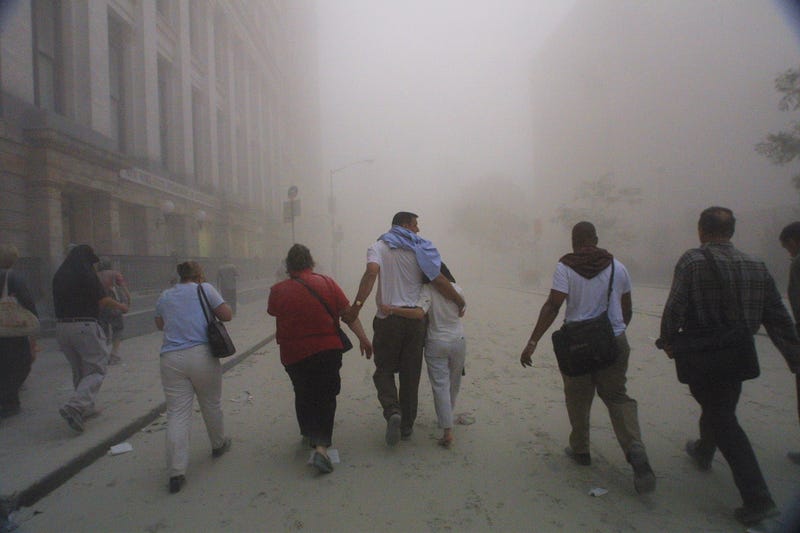
Civilians flee as a tower of the World Trade Center collapses September 11, 2001 after two airplanes slammed into the twin towers in an alleged terrorist attack. Photo credit (Photo by Mario Tama/Getty Images) Up in the sky that morning, Kaminski was just reporting traffic as usual when he saw what he called “the flash and the fireball” on the North Tower.
Even as Carroll patched him in to report what he was seeing, it wasn’t until he his pilot received word from air traffic controllers stating, “The airspace has been sterilized,” that they began to worry.
What scared them the most wasn’t the phrase itself, but rather the fact that as experienced as they were they had never heard it before. That’s when the seriousness of the situation started to settle in.
Kaminski continued to do his job until his helicopter was finally grounded. In fact, he points to one moment in the broadcast, right after the South Tower was struck, where you can hear him start talking about the traffic.
“I just needed to center myself,” he says, after realizing his hands started to shake.
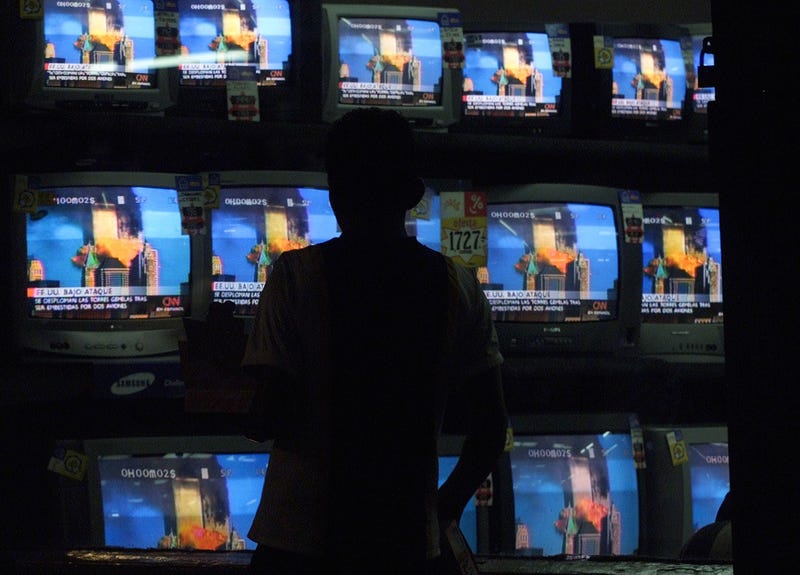
Guatemalan pedestrians watch on TV September 11, 2001 in Guatemala City, Guatemala the moment when a second plane commandeered by unknown hijackers slammed into New York’s World Trade Center. Photo credit (Photo by Andrea Nieto/Getty Images) “And doing traffic, which I had done for all these years, was exactly how I did that,” he continued, “I start talking about traffic on West Street, and on Canal Street, and I talked about vehicles coming down into [that] area from every conceivable direction. That was for me.”Guatemalan pedestrians watch on TV September 11, 2001 in Guatemala City, Guatemala the moment when a second plane commandeered by unknown hijackers slammed into New York’s World Trade Center. Photo credit (Photo by Andrea Nieto/Getty Images)
When he didn’t know what else to do, Kaminski just did his job. Looking back on that day, former 880 anchor Jeff Kaplan agrees that every reporter that day was “on autopilot.”
He recalls watching a random 9/11 special on TV one year where the entire day was synched up to pictures, video, and audio. It wasn’t until he saw people “gathering around somebody’s radio, holding hands [listening to] our voices…listening with tears coming down their faces,” he wasn’t aware of how much 880’s coverage – or any coverage – meant to the average listener that day.
He says that seeing, “the way that people perceived what [they] were doing,” made him lose it.
See WCBS Newsradio 880’s 9/11 anniversary coverage here.
-
‘Hope, Resiliency, and Strength:’ Lasting Message of WTC Site 20 Years after 9/11
Post Views: 666By Joe Connolly and Neil A. Carousso
NEW YORK (WCBS 880) — The World Trade Center site is a living, breathing memorial of the people lost in the September 11 terrorist attacks, a bustling business district and architectural wonder that stands tall as a sign of freedom and New York’s resilience in recovering from the fateful tragedy.
“I think there is a responsibility that whatever sadness and tragedy has befallen a place, at the end, there needs to be a message of hope, resilience and strength,” said architect Daniel Libeskind on the WCBS Small Business Spotlight, sponsored by Dime Community Bank.
The tear-jerking reflecting pools, the breathtaking Freedom Tower, and the awe-inspiring Oculus Transportation Hub were all part of Libeskind’s master plan to revitalize the site after 9/11.
“That’s what the spirit of humanity is. It’s not just to give in to the irretrievable and irreversible past. It’s to show that we can overcome it; we will not forget it,” he said.
Libeskind is a world-famous architect whose designs include the Jewish Museum Berlin and hundreds of modern buildings enjoyed by millions around the world from the United States to Europe and beyond. He was born and raised in Poland to Holocaust survivors and was among the last to immigrate to New York by boat into Ellis Island.
“You have to be a lucky man to be living in New York to be able to take the subway or walk somewhere into a corner of New York that is maybe 10 blocks away from you but it’s a different New York,” he said, continuing, “That’s the beauty of New York. You move a few blocks and you’re in a different neighborhood. New York is really a kaleidoscope of diversity.”
Libeskind told Joe Connolly and Neil A. Carousso that exploring and experiencing the city is a quintessential act for himself as an architect, but said it can be inspiring for anyone. Attracted to the energy of New York City, he is confident the offices at the World Trade Center will be at full capacity again after the COVID-19 pandemic, because while working from home is convenient, he believes the collaborative and creative work that can be achieved in the social space of the office is unmatched.
“There’s no doubt that offices will continue to play a key role and I really know it from my own office, which is in Lower Manhattan, that it’s so inspiring to have people back in the office, seeing each other, working together. It’s irreplaceable. You can never do it from your home that way,” Libeskind said.
He noted many offices are being reconstructed to meet the new pandemic demands of distance and ventilation and supports converting empty offices into residential buildings.
“When we were building Ground Zero, many of the great office buildings, which were already modern office buildings, were being converted to residential buildings and that has brought a lot of life to Lower Manhattan,” said Libeskind, hopeful that doing so now will improve the city’s affordability.
He told WCBS 880 he has been working on designing modern New York City Housing Authority (NYCHA) buildings for elderly residents in Brooklyn and Long Island City and believes introducing quality architecture and greater living space will attract new, talented people to live and work in New York.
Watch Joe Connolly and Neil A. Carousso’s conversation with world-famous architect Daniel Libeskind for a reflection on the World Trade Center revitalization and discussion about New York City’s post-pandemic future on the WCBS Small Business Spotlight video above.
-
NY Business Leader on Why Pandemic Recovery is More Complex than 9/11
Post Views: 745By Joe Connolly and Neil A. Carousso
NEW YORK (WCBS 880) — Kathryn S. Wylde has been president of the Partnership for New York City since 2001, thrust into the devastation of 9/11 and the business recovery effort when fear of another terrorist attack clouded whether Manhattan would ever come back.
Wylde hosted strategy sessions with then-Governor George Pataki and Sens. Charles Schumer and Hillary Clinton at the Partnership’s Downtown offices in the aftermath. But, she told Joe Connolly and Neil A. Carousso on the WCBS Small Business Spotlight, sponsored by Dime Community Bank, that the economic issues were more clear 20 years ago compared to the complexity of the COVID-19 pandemic.
“We were able to be ready for recovery by January,” she said. “We hosted the Davos World Economic Forum at the Waldorf and had thousands of notable leaders of countries and businesses from around the world flying into New York.”
International travel is still not fully open. The city’s offices were not open at 100 percent until June 15, 2021 – 15 months after the coronavirus forced large-scale shutdowns to control the spread of the disease.
Wylde says New York has suffered immeasurable financial losses as a result of the pandemic.
“On 9/11, we had the temporary displacement of 3,000 small businesses and we lost about 130,000 jobs – most of which were recovered completely within a year and a half/two years. Today, we’re down 462,000 jobs and we don’t know how many of those are going to come back,” the business leader said.
She told WCBS 880 that small businesses in retail and hospitality may never be the same. But, there has been record venture capital investments in new professional services companies that are catering to pandemic needs. Their biggest challenge, Wylde said, is competing for workers.
The Partnership for New York City lists 387,000 open job postings. With a tight labor market and a work from home environment, hiring skilled workers remains a major hurdle this fall.
“Today, we’re economically, at a macro level, in better shape, but the implications of this whole remote work situation and what’s happened to our brick-and-mortar economy – the small businesses – which are 9 percent of the economy but they’re 20 percent of the jobs – we don’t know how much of those are coming back – both the businesses or the jobs. We don’t really know the damage caused a year and a half into this,” Wylde said, noting large businesses are better positioned for the post-pandemic economy because they amass greater resources.
She is concerned emerging variants of COVD-19 that are more transmissible and more contagious, and potentially could weaken vaccine efficacy, might require new shutdowns that could wipe out some sectors.
Despite the widescale problems, Wylde remains optimistic about New York’s recovery. When asked how she keeps going, she told Connolly and Carousso she is encouraged that communities have come together, which she said is reminiscent of the 1970s and early 1980s when the city was faced with a fiscal crisis that ignited a seismic shift from mostly industrial work to a service economy.
“The same thing I’ve seen happening while government was focused full bore on the health crisis, communities came together to support each other, and to provide services, and to make sure neighbors had groceries, and that the elderly had visitors, and that the health care workers were applauded with pots and pans as they were going off to save lives,” Wylde explained. “I’ve seen communities come together in a way that demonstrates the strength and resilience of New York.”
Watch Joe Connolly and Neil A. Carousso’s full conversation with Kathryn Wylde on the Small Business Spotlight video above.
-
World Trade Center Performing Arts Center Aims to Lead NYC’s Cultural Revitalization
Post Views: 652By Joe Connolly and Neil A. Carousso
NEW YORK (WCBS 880) — The Ronald O. Perelman Performing Arts Center is the last piece to the recovery and revitalization of the World Trade Center site after the September 11 terrorist attacks. It will also aid in New York’s pandemic recovery when it opens in 2023 – delayed because of COVID-19.
“The performing arts sector is the last to come back, but it’s coming back roaring,” said Leslie Koch, president of the Perelman Performing Arts Center.
On the WCBS Small Business Spotlight, sponsored by Dime Community Bank, Koch pointed out to Joe Connolly and Neil A. Carousso some parallels between the 9/11 and pandemic recovery efforts.
“The planning back in 2003 that resulted in the master plan said we need to have culture on the 16 acres because New York needs to not only memorialize what was lost here on 9/11 and rebuild the offices that were destroyed, but this site needs to be a living, breathing part of New York,” she said. “We’re that symbol again.”
She believes that people are suffering “creative loss” by working remotely because New York City offers a vibrant experience of arts and entertainment, which attracts many people to the city in the first place.
When the Perelman Performing Arts Center opens, it will be a public place where arts and entertainment intersect with New York’s restaurants and financial industry.
Koch describes it as the “living room of the World Trade Center” where it will host free performances on a small stage on the first floor and a variety of theater, dance, film, opera and more music upstairs.
“The Perelman Arts Center at the World Trade Center is a critical piece not just for the revitalization and return of Lower Manhattan, which is an office district and also a place where thousands of people live and millions of people visit, but also for New York broadly that New York is always investing again,” Koch said.
She sees culture as the vehicle to get New Yorkers to participate in the economic recovery.
Before leading the World Trade Center’s arts project beginning in 2019, Koch oversaw the redevelopment and rejuvenation of Governor’s Island from a military base to a park and thriving business and recreation center. She served as president and chief executive officer of the Trust for Governor’s Island from 2006-2016.
Connolly asked her what advice she has for young artists looking to make it to the big time. Koch responded by saying, “Follow your passion and know your numbers.” She noted that’s applicable to people in any industry.
“One of the great things about when artists follow our passion is that that’s something that the rest of us get to experience and enjoy,” she added.
The pandemic shut down impacted businesses and workers across the hospitality industry. Entertainers were among those who struggled to survive when performances were canceled. Koch told WCBS 880 many artists discovered new creative ways to reach audiences virtually.
“You put a performance on the screen, and all of a sudden, you have audience members in Tanzania, and Singapore, and Utah. New York is the capital of the arts for the world and I think that digital is helping make that even stronger,” she said.
Get an inside look at the development of the Perelman Performing Arts Center at the World Trade Center and see how performances are helping the city emerge from the pandemic on the WCBS Small Business Spotlight video above.
videos
Social Feeds

VIDEO: Told the airline to book us on the next flight out (SPONTANEOUS TRIP!)

VIDEO: The Taylor Swift Effect | WCBS Business Breakfast

VIDEO: Future of NYC | WCBS Business Breakfast

VIDEO: Reasons for New Yorkers to be Optimistic | WCBS Business Breakfast

VIDEO: NYC's AI Chatbot | WCBS Business Breakfast

